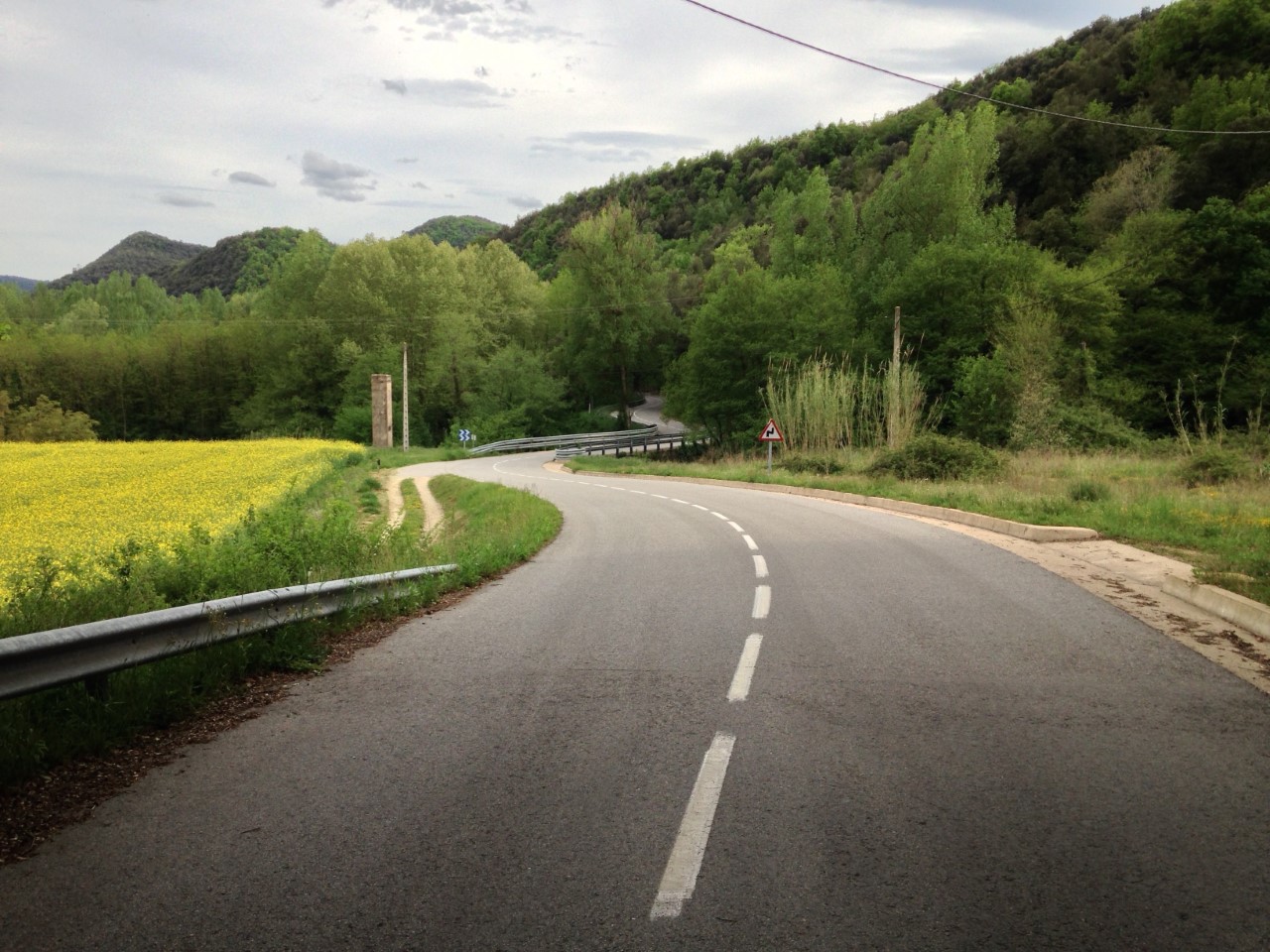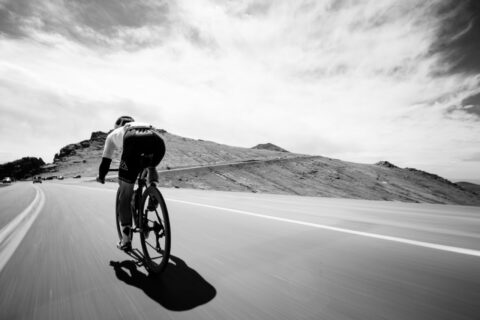Pick a flat or mostly flat terrain, start biking, then listen to Colby Pearce’s moving meditation podcast to relax and think deeply as you ride.
Episode Transcript
00:12
Welcome to the Cycling in Alignment podcast, an examination of cycling as a practice and dialogue about the integration of sport and right relationship to your life.
Colby Pearce 00:53
Hello Cycling in Alignment audience. Thank you for joining me today. We’re going to do a little bit of a left turn con-sonar crazy Ivan, I’m going to take an idea that was given to me by a colleague, a couple of coaching colleagues, and expand on it.
Colby Pearce 01:10
A few weeks ago, maybe a month ago, I heard a podcast on the Fast Cat podcast channel, that’s Frank Overton, and Jackson Long, and they did something I thought was quite creative and interesting; Jackson read a meditation for cyclists while they’re riding the bike. And I listened to it, I wasn’t riding at the time, I was gardening actually moving stones, but I thought it was a really interesting idea. And immediately, I had the instinct, the intuition that I should do one of my own and expand on it for listeners, for my audience. And so I want to say thanks to Frank and Jackson for coming up with this idea, because it definitely inspired me to bring my own little twist on this theme.
Colby Pearce 01:58
The reason it resonated with me so much is because I frequently ride by myself, of course, in 2020, a lot of people ride by themselves. So it’s given us chance for internal reflection and a chance to connect with a bike in a different way, maybe, especially if you’re a person who kind of tends to always race or do group rides, or even do your easy rides with your buddies. And depending on how extroverted or introverted you are, that may be a really big struggle or it may be a really wonderful opportunity for you to re-energize because introverted people gain energy when they look inwards and spend time by themselves. They’re kind of classically they’re drained by being in interaction with others. And extroverts are sort of the opposite of that paradigm. And I think all of us probably have some introvert and some extrovert in us. In general, it’s not a very broad brush, but we also have probably a tendency towards one paradigm or the other, one archetype of the other.
What is meditation?
Colby Pearce 02:51
So, meditation can take many different forms. Meditation can be what most of us think of when we think of meditation is a very still practice. Probably sitting with your legs crossed, spine, straight, eyes closed and zenned out and thinking about one single thing or no thing, I am no one, I am no time, I am no place, I am no thing. That’s one form of meditation. We can also practice in moving meditation. And in my experience, for in particular for athletically minded people, people who grew up in the Western world we’ll say, a moving meditation might be more digestible, especially if you are beginning a meditation practice, you’ve not adopted one into your life at this point. If you’re used to ride your bike for five hours a day, many days a week for many years of your life, sitting in one place, for an hour or two might be an incredible challenge or even for 20 minutes. That said, there are people have done it, including my brother Jeremy, who loaned me this amazing instrument…This is a handpan, by the way, in case you’re wondering, I’m going to use this to help give a rhythm to today’s meditation.
Colby Pearce 04:10
Jeremy and his wife, Heather, are former professional racers, and they chose to adopt daily practice of meditation of one hour and they did it for an entire year. These two are elite athletes. So if they can do it, that means you can do it. That said, I think that it can be useful for us to think about moving meditation is like a gateway drug, a way to step into a meditative practice. And maybe it grows and develops into different ways and if you do it for a while, then you are inspired to explore other paths of meditation. In my experience, working with different clients and different personality types. Some athletes will start meditation and immediately dive very deeply into it, they just embrace it, it’s something their soul has been craving or hungers for. Other athletes really struggle to get that practice kindled or ignited. Why is that? Well, maybe it’s the form that they chose, or the specific type they practiced with wasn’t the best resonance for them. There’s a lot of individuality and how you’re going to react to a different meditative practice. So we’re gonna put some resources at the end of this pod, I’ll briefly go over them, and then we’ll drop some links in the show notes. So if you’re interested in trying different types of meditation, I’ve got some really good directions to send you in some seeds to plant. And then we can let things flower and grow.
Colby Pearce 05:39
So, when we think about are still meditation, as I said, that can be that can take many forms, it can be eyes closed, focusing on something internal, focusing, trying to empty the mind that one is perhaps one of the more challenging for many people. You can also use a still meditation, for example, by focusing on an object in the visual field. A good one is a burning candle. Another one is a star. Sometimes at night, I’ll go outside and stare at a single star; I would invite you to try this, if you stare at a single star for 10 minutes, you can have some pretty crazy experiences. Well, I do anyway. Be surprised what you can get out of it.
Colby Pearce 06:20
So if you have a practice, maybe you’ve not thought about meditating on the bike. We probably don’t think of it that way, conventionally. The bike is a place where you do work, you do yang, you smash the intervals and do the things and make the watts. That’s okay, we don’t always have to treat the bike that way and perhaps by entering a meditative state while we’re riding, we might start to think about the bike in different terminology, frame it in a different way in our mind.
Some suggestions before you try moving meditation
Colby Pearce 06:46
Some suggestions for this practice: this is intended for you to do while you’re riding the bike. That said, I’ve got to get a few things out of the way. First of all, we’d prefer ideally for you to pick flat or mostly flat terrain, terrain that is not obfuscated with a lot of things like stoplights and potholes and people, not a busy bike path, not a lot of turns, not a lot of rolling hills. And the second point that directly stems from that is, no matter where you are in this meditative process, you need to understand that you are responsible for and obligated to always keep a direct awareness of your environment. Just because you’re zenned out and thinking about your pedal stroke doesn’t give you license to ignore cars that turn in front of you, dogs, cats, ice, sand, potholes, small children, flying objects, whatever else you might encounter on the bike. So we’re here to be aware, you’ve got to accept the fact that during cycling, we need to have our reticular activating system on which is a low level alert for threat. We want to dial that down to the absolute minimum, that’s part of the idea. But it still needs to be on that channel is on an active.
Riding with headphones, Colby’s personal opinion
Colby Pearce 08:00
To that end, let’s have a discussion about headphones. Some people feel that riding with headphones is unsafe. The argument I’ve been given in this discussion most of the time is that they people want riders want to have a higher level of auditory acuity so that they can hear cars approaching them. To me, this argument doesn’t really make that much sense. And I’ll explain why. And I’m definitely open to discussion on this. But if you’re riding on a road by yourself with two headphones in, or well, let’s say with headphones out, and you’re hearing traffic noise, in my mind are three logical outcomes for how this could play out. One is there’s a car that’s driving the speed limit and approaching you from behind. And it’s going to hit you. The second scenario is the car is traveling at the speed limit, and it’s approaching you from behind and it’s not going to hit you. In my thought experiment, these two cars sound identical, you’re not gonna hear the difference. Because a car that’s moving in your direct path won’t be any more, won’t make any different sound than one that’s going to be three feet to the left.
Colby Pearce 09:12
The second problem is that even if you heard a noise – wait, let me rewind, the third probability is that someone is about to hit you and they do something with a car that tells you this. They hit the brakes, or they make an abrupt turn or they’re just going incredibly fast and that gives you that makes the hair on your on the back of your neck stand up or gives you a feeling of unease. How are you going to react to that? This is assuming you don’t have a mirror so you’re not looking and you don’t have time to turn your head around and you’re not gonna have time to turn around and look. So if that’s the case, let’s say that the car is out of control because someone made a mistake and they’re heading towards you. Are they going to hit you square on? Or are they going is – are you going to hit by the left side of their car because they’ve turned hard enough to the right to where they’re basically headed for the ditch, but they’re still going to clip you or are they almost barely going to hit you with the right side of the car because they are not going to pass you with sufficient room? Well, if you heard that car coming, and you heard the brakes lock up, even if you had a chance to react, would you choose to ride into the ditch or into the road, you basically have a 50/50 chance of getting a picking the right or wrong choice. So I would argue that hearing a car that’s locking up its brakes coming at you won’t really get you anywhere.
Colby Pearce 10:36
Now, counterpoint to that is that if you have more information about the situation, you may be able to craft a deeper intuition as to what to do and how to react. If you’re really plugged in, and you’re doing your meditation, you’re tapped into the field, we’ll say you’ve got a strong instinct for what’s coming even though you can’t necessarily pinpoint it, sort of a dark fuzzy cloud, then you might argue that having more auditory information will help you refine that instinct. I don’t know if I by that I kind of think those things go beyond hearing in the moment, I think you would already feel that energy. And I’ve had multiple instances in my cycling experiences where I’ve had that exact paradigm play out; I felt like a dark cloud over my head, and in retrospect, I see clearly what was happening in the moment, I couldn’t quite figure it out until it happened. And then I crashed and broke bones or saw someone else get hit by a car. This has happened to me a few times. Yeah. So it’s a little, it is what it is, I consider it a way for me to be tapped in and understanding of what’s happening. And now that I’ve had those experiences, if I have them again, hopefully, I can take pause for a moment and think about what the choices we’re making are and avoid someone’s injury, or my own. I don’t really like breaking bones, I prefer to keep them intact.
Colby Pearce 11:56
So another option would be you could consider using a headphone like the aftershocks, which it’s a headphone that doesn’t actually put anything in your ear hole or your auditory meatus, never get a chance to use that term, it uses a conductive technology that touches the bone behind your ear, and then you’re able to hear sound but your ears are unplugged. That’s one option. I don’t I ride with headphones pretty frequently myself for the reasons I’ve just disclosed. And also I don’t ride in traffic that often. Most of my roads are on gravel or very lightly driven roads ideally, or straight up in the mountains on trails, a lot of single track, that’s what I’m on. So for what it’s worth, if you’re uncomfortable riding the bike with both headphones in one option is you could use aftershocks. Another would be you put one headphone in and leave the other out. And I would suggest if that’s acceptable to you, you leave the right headphone in and leave the left one out. That’s the traffic side. Then if you feel like that, hearing that traffic noise is important to you and it’s going to help you feel a little safer, then that’s a possible solution. The other solution is do this meditation on the rollers or the trainer. Winter is coming in most parts of the country, except for those of you who live in San Diego or Tucson or Florida. And so you might, you might practice this indoors. And once you do it a few times and you get the idea you might establish a rhythm and then be able to walk yourself through the meditation while you’re riding outdoors. Some suggestions.
How to focus on breathing
Colby Pearce 13:31
Another point during this meditative practice, ideally, I would like you to try to breathe nasaly. This means thinking about the breath as a box. Side one is the inhale, side two is the hold at the top of the breath, side three is the exhale and side four of the box would be the hold at the bottom of the breath. For this exercise, we would use a count of 4,0,4,0; meaning inhale count of four, exhale, hold at the top is zero seconds. So we’re just going to go straight from inhale to exhale, exhales four seconds and then at the bottom, we’re also not going to hold we’re going to go straight from exhale back into your inhale. So that would sound something like this…
Colby Pearce 14:31
If you feel that you are unable to breathe nasaly during your riding practice, a way to regress this exercise would be to inhale through the nose and exhale through the mouth. If you feel like it’s too much to do that, that’s a way to kind of provide some relief. If that doesn’t work, or maybe you make it partway through the meditation on inhale, exhale nasal and then you progress to exhale through the mouth, then you feel like it’s too much pressure, you’re feeling low on O2, we do not want anyone to get lightheaded, do not pass out obviously, not the objective. What we’re trying to do is get a nice easy rhythm. And if that rhythm becomes challenging and you’re distracted from the cues I’m giving you or the process of the meditation because you’re really focusing on the breath and feel like you’re a little out of breath, then that’s a clue that you should probably lighten up and regress the exercise either to mouth exhale or to inhale and exhale through the mouth, and work on it considered a practice.
Colby Pearce 15:31
For what it’s worth. Why would we naturally breathe? Well, simply put, mouth breathing up regulates sympathetic nervous system activity, nasal breathing, down regulates sympathetic, breathing activity, and up regulates parasympathetic. So that’s our first choice for this type of ride. If you haven’t explored that yet I’ll also leave a great resource to try some off the bike breathing exercises in the shownotes. It’s called Soma breath. They’ve got a free intro course, that I think is seven days and it’s like 10, or 15 minutes a day and it teaches you a lot of really good basics. So there’s a little seed planted on that into another world of breath. And if you aren’t working with your breath, and you’re an endurance athlete, you are missing a major stones on turn, I’ll just let you know that. If you have a breathing pattern dysfunction, you have a core dysfunction. And if you don’t have core strength, how are you gonna ride a bike fast?
Colby Pearce 16:27
We’re actually going to release two files on the same day, one will be the complete podcast recording, including everything I just spoke about. And the meditation for on the bike, we’re also going to release a separate file, which will be a much shorter show, which will basically only be the on the bike meditation. The reason for that is, I don’t expect you or ask you to listen to the intro and all the other ramblings I just made every time if you want to practice this on bike meditation; We’ll give you a separate file for that and you can keep that and use it a few times if you’d like to practice it. Hopefully people find that useful and interesting. If you do end up using this on the bike, please give me some feedback and let me know. If you think that on the bike meditation can be improved or you’d like to see some other aspects included, send me some feedback, because I’d be happy to do some more of these if people find them to be really useful.
Colby Pearce 17:23
One last note, during this meditation practice, while you’re riding on the bike, I’m going to make a little suggestion, take a small piece of electrical tape. Use it to cover the power and heart rate numbers on your head unit while you’re riding. Record but do not observe. We don’t need to watch power or heart rate when we’re doing this kind of activity. We’re here to do other things. So it’s fine to record it and put it in your training load assessments and your software you’re using whether that’s training peaks or today’s planen or whatever you’re on board with. But for today, we don’t need to see the digits.
Colby Pearce 18:11
So with that, let’s begin. I’ll walk us through our meditation. I’m going to do a gentle rhythm on the hand pan.
The start of the moving meditation
Colby Pearce 18:43
Start by focusing on your breath – in through the nose with a count of four. Four pedal strokes, inhale four pedal strokes and out exhale. If that pace is too quick, you can count four pedal strokes on one leg for each inhale and exhale. It’ll depend a little bit on your cadence. But the important part is to find a rhythm that works for you.
Colby Pearce 19:44
Feel the pressure on your hands as they grip the bars. Do you have even pressure on the left and right hands? What is the texture of the hoods or tape? Do you feel the texture of the asphalt, pavement, or dirt coming through the bars and into your hands?
Colby Pearce 20:54
Feel the pressure off your feet on the pedals. On each pedal stroke, try to feel the foot as a perfect tripod. Three points of contact: the center of the heel, under the ball of the foot, and under the ball of the pinky toe. Drive drive the pedals with large smooth circles.
Colby Pearce 21:59
Feel the power the strength originating from the hips. Visualize power coming from your center, your don ten which is just below your belly button deep in the core. This is the center of your creative energy, your drive, your will, your desire to make the bike express your strength.
Colby Pearce 23:38
Return to the breath. Inhale to the count of four. Exhale to the count of four. Feel the lungs inflate, the belly grow on each inhale.
Colby Pearce 24:17
Feel the spine extend on each exhale. Extension through the crown of the head. Your neck is in line with your spine. Roll your eyes up to see the road in front of you.
Colby Pearce 25:38
Feel the sensation of work in your legs. What do you feel? Are your legs burning? Do you feel tension in the muscles? Observe the sensations of supple, smooth muscle action. Are you choosing to assign value to the sensations you feel? Is burning good? Is burning bad in the muscles? Observe your reaction.
Colby Pearce 27:25
Observe the sensation of work in your lungs.
Colby Pearce 27:38
Notice as the lungs inflate and deflate, exhale co2 What do you feel?
Colby Pearce 27:55
Do your lungs burn? Do they feel warm? Do they feel cool air? Do you feel the strength that the atmosphere gives you to help you propel the bike.
Colby Pearce 28:34
Return to the rhythm of your breath. If you lose the rhythm just return to it.
Colby Pearce 29:10
You are here to observe, not to judge.
Colby Pearce 29:29
When your lungs burn from hard efforts on the bike, do you see that burning as good or bad? Or do you simply feel without assigning value?
Colby Pearce 30:25
Now turn your attention to external sensations.
Colby Pearce 30:42
Feel the wind on your face. Feel the wind on your arms. Feel the wind on your legs.
Colby Pearce 31:30
Feel the texture of the road as it engages your tires. Can you feel small undulations in the pavement? Can you feel the grain of the asphalt gripping your tires?
Colby Pearce 32:16
Return focus to the breath. Exhale to the count of four. Inhale to the count of four.
Colby Pearce 32:40
Do you hear the sounds of nature? Cycling is about connection with nature. Do you hear birdsong? Dogs? Water? Wind? What other natural sounds are part of your conscious experience.
Colby Pearce 33:42
Observe the color of the road. The color of the land as you pass by. buildings, grass, dirt, trees.
Colby Pearce 34:08
Notice the quality of the light. Is the light filtered by the atmosphere or translucent?
Colby Pearce 34:41
Notice the color of the sky.
Colby Pearce 34:57
Look at the road in front of you. Observe the road as it meets the horizon. The point where land and sky are joined. How far away can you see? What is the point of road, you can see that’s closest to the horizon farthest from you.
Colby Pearce 36:13
What is the point closest to your front wheel. Look at the road surface directly in front of your tire. See the speed at which you travel over the earth.
Colby Pearce 36:39
And return to the breath. Count of four for each exhale, count of four and for each inhale.
Colby Pearce 38:06
Cycling can be about more than watts and power and speed. Cycling can be about connection with self, connection with body, coherence of body and mind. Cycling can be about connection with nature.
Colby Pearce 39:20
Thank you.
Colby Pearce 39:20
I hope you enjoyed that. One take had a few rhythm interruptions there still learning handpan. Thank you Jeremy for the opportunity to play with this magnificent instrument. I love this thing. So much fun. I use this instrument at home to engage in what Paul Chek would refer to as unbound play. Unbound play is an important part of being alive. It’s an important part of being a human or an animal. Dogs practice unbound play when they chase their balls. Cats, when they randomly run around the house BB banging as we refer to it, play with a ball of yarn or, or a bottle cap on the hardwood floor. That is play that doesn’t have an end goal in mind, it’s not an objective, there’s no end result, there’s no magnificent museum painting or going to sell for a million euros. It’s just play in of itself. And if the product of that play ends up falling over, or being destroyed or having coffee spilled on it, that’s okay. When you use a musical instrument to make unbound play, it just escapes into the universe and hopefully, it makes people happy.
Colby Pearce 40:45
I hope that you found that meditative exercise useful. And I hope that my slightly broken rhythm at times didn’t distract you from the practice. It was designed to give us some sense of pacing, but also ultimately, a meditative practice, when taken to the highest form should be able to take place in almost any environment. That is, it’s easy to be a monk when you lock yourself in a cave. And it’s very easy to have a spiritual practice and never be upset, or not be reactive when you hunt salmon out of a river and live on a mountainside by yourself. If you want to really develop some spiritual robustness, that’s a terrible word, spiritual foundation, a foundation of spiritual practice, which involves letting go and being less reactive, less judgmental about yourself and others. The best place to do that is amongst the people; all the reactive people, all the noisy people, all the people that upset you and piss you off. Because there’s your chance to not be reactive. So…
Colby Pearce 42:13
Thanks, listeners, if you enjoyed today’s podcast, or you thought it was total crap, either way, I’d like to hear from you. cyclinginalignment@Fast Talk Labs.com. Don’t forget, check out my website, Colbypearce.com got all kinds of goofy pictures on there. It’s a constant work in progress. Updating is a thing that happens. I have been getting some great feedback from my listeners. And, again, I really appreciate all your input. I’ve had some some questions that have challenged some of my thought process recently. And that’s one of the reasons I do this. So don’t be shy. If you think that I said something poorly or totally wrong, hit me. I’d love to discuss it. I’m accruing enough of these to where at some point I will do a q&a. And I’ll talk about some of the questions I’ve received or the comments I’ve had. And then we’ll go through it. Maybe I’ll get Chris to come and help me out with that, because he’s good at that kind of stuff. Chris Case do man. Thank you everyone. Have a wonderful day, and enjoy riding.
Colby Pearce 43:10
Thank you for listening to the cycling and alignment podcast. I hope you enjoyed today’s show. If you have some feedback about the show, you can email me at cycling in alignment@Fast Talk Labs.com. That’s all just like it sounds cycling in alignment at Fast Talk Labs.com. We will also put the link to this email in the show notes and some links to some socials in case you want to hit us up there. We appreciate the positive feedback if you like the show, if you didn’t like it. Well, that’s okay. Let me know about that too.
Colby Pearce 43:45
Listen up monkeys. The thoughts and opinions expressed on this podcast are those of the guests or me. They do not represent Fast Talk Labs, Fast talk, Chris Case, Trevor Connor, Santa Claus or anyone else.
Colby Pearce 44:01
Thanks. Good day.




